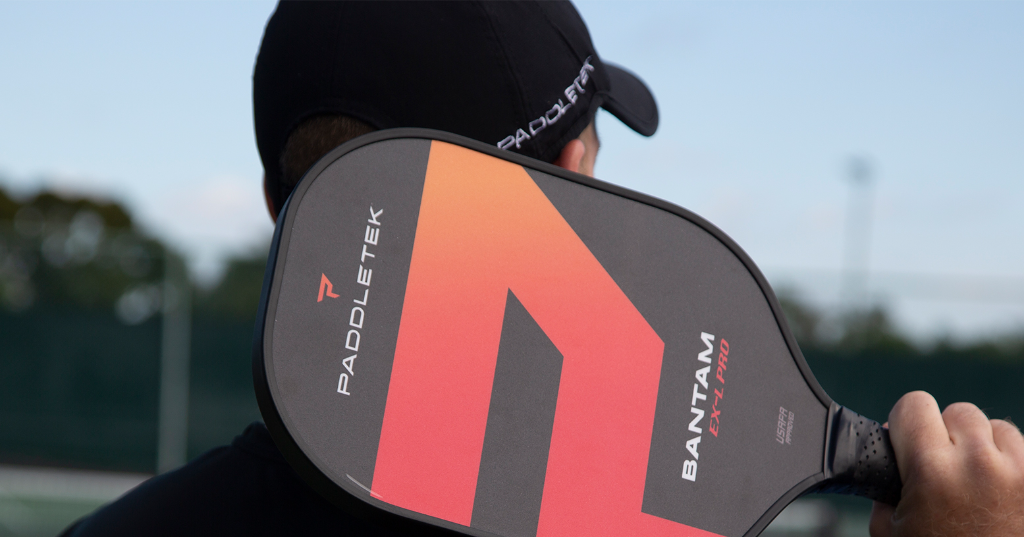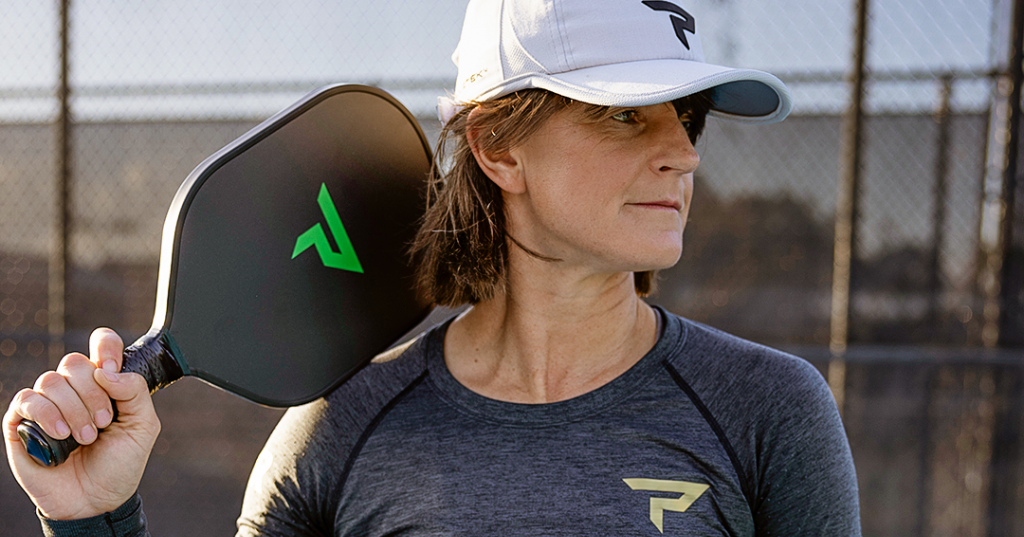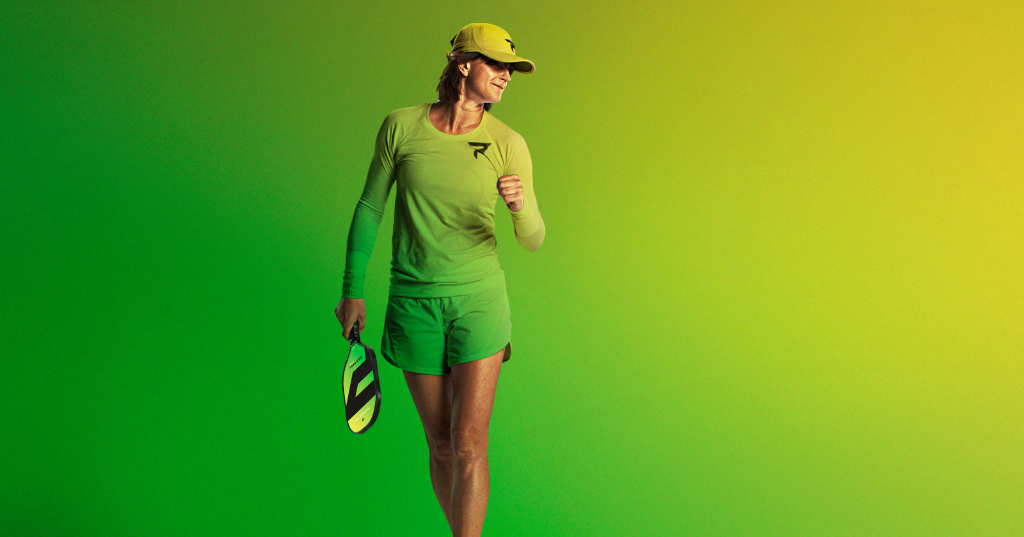While most Americans have now heard of pickleball, less than 2% of them have ever played. But as the sport continues to skyrocket in popularity, more and more people aren't asking what pickleball is, but instead, how to play it. So then, in its simplest form, how is pickleball played?
Pickleball is a paddle sport that's played on badminton-like courts with nets slightly shorter and lower than tennis nets, a ball akin to a Wiffle ball, and a hard paddle. Played as singles or doubles, only the serving team scores on the path to 11 points per game, winning by a 2-point margin.
Although pickleball has simple rules, it's a rather nuanced game. This guide will break down the most important elements of the game so that even if you're a complete beginner, by the time you’re done reading, you’ll know enough to hit the courts with confidence.
What Is Pickleball?
Pickleball is a paddle sport that’s often described as a hybrid of tennis, Ping-Pong, and badminton. Although blurred across all three sports, playing pickleball requires court movement like that seen in tennis, the wrist action and speed of Ping-Pong, and similar fitness to badminton.
As you know, Americans love their sports; football, baseball, basketball, and hockey are pillars of entertainment for the entire country. But this fanatical appreciation makes it difficult for any other sport to earn attention. And yet, pickleball has done just that.
This makes pickleball's origin story unique and worthy of a brief explanation, as it's accomplished what nearly all other emerging American sports haven't been able to in the past 50 years.
The Humble Origins of Pickleball
Pickleball was invented on Bainbridge Island, Washington, in 1965 by a group of friends and their families looking for ways to entertain their children while on vacation. The first game was played on a backyard badminton court using modified table tennis paddles and a Wiffle ball. Rooted in accessible fun, this carries on today.
Pickleball certainly wasn't an overnight success, but its grassroots growth started as soon as the vacation ended. Relying primarily on word of mouth, pickleball now has over 4.8 million players in the US.
Pickleball history is filled with highlights over the past nearly 60 years, but can be roughly split into 5 stages:
- Pickleball Is Founded and Forged | the 1960s: This period consists of establishing the foundations of the sport, including rules, net and court dimensions, and the first serious paddle.
- Pickleball Gains Legitimacy | the 1970s: In this phase, pickleball builds credibility as an organized activity with the construction of the first permanent pickleball court, the first official pickleball company opening for business, and even the media covering pickleball.
- Pickleball Shifts from a Game to a Sport | the 1980s and 1990s: The key difference in this period is establishing competitive play for pickleball, moving it from a game to a sport. This includes launching a tournament and creating a governing body. Also, creating and selling the first composite pickleball paddle helps foster competitiveness.
- Pickleball Surges in the Millennium | the 2000s: In 2001, the Arizona Senior Olympics rallied around pickleball, building participation among older adults. Good Morning America featured pickleball in 2008 and the first USAPA National Tournament in 2009.
- The Pandemic and Pickleball Today | Today: During COVID-19, Americans flock to pickleball, increasing membership by 20% between 2019 and 2021. The Margaritaville USA Pickleball National Championship draws 2.3K players in 2021.
Although this timeline is certainly an oversimplification of the more detailed growth of pickleball, it shows how its accessibility and entertaining roots still drive demand for pickleball today, leading more players than ever to learn pickleball.
How to Play Pickleball, for Beginners
It's time to jump-start your pickleball education because, by the end of this section, you'll know more about how to play than most players do after their first few matches.
This how-to distills nuances of pickleball into their most basic forms and organizes the information into 3 groups for your first day on the court: what to bring, stepping on the court, and the rules you should know in advance.
Now then, let's get started!

1. What Should You Bring Your First Time Playing Pickleball?
Assuming you have a court to play on, you only need three things to play pickleball: a paddle, a ball, and shoes with non-marking soles. And for your first game, you most likely only need to bring one of them along.
Borrow a Paddle
As a manufacturer of premium paddles, it may seem counterintuitive that we'd tell you not to buy a paddle. But if this is your first time playing, the truth is that in most situations, there will be a paddle or two available for you to use at the courts.
This is especially true if you're headed to league play or popular courts.
And no, you can't use your tennis racquet from junior high or your table tennis paddle from downstairs. Aside from paddle regulations, other racquets or paddles won't work since pickleball paddles are bigger than those used in Ping-Pong but not quite as large as tennis racquets.
Most players carry multiple pickleball paddles, some just to loan out to beginners like you. Aside from borrowing from generous strangers, getting one from a friend or calling the courts ahead of time to see if they have loaners are better solutions.
Resist the urge to buy a cheap paddle off Amazon. Rather, get some matches under your belt before you buy. Gauge your interest in the sport and learn what type of paddle you like, then invest in a great beginner paddle.
Pickleballs Are Everywhere
Much like paddles, there will usually be a ball or two (or 50) available for use at the courts. Unless it's just you and another first-timer hitting the courts in an isolated location, you can almost bank on the facility or other players there having pickleballs to use.
If you find yourself still needing to purchase pickleballs, take note of where you'll be playing and the difference between indoor and outdoor balls. They look similar to beginners but play completely differently.
Spot the difference by examining the size and number of holes on the ball; generally, indoor pickleballs have 26 holes with diameters roughly the size of dimes, whereas outdoor balls have 40 holes with smaller diameters. Also, indoor pickleballs are a bit lighter than outdoor versions.
Some balls can be used on both courts. Just do your research before purchasing.
Footwear Matters
Finally, one thing you should certainly bring is a pair of court shoes with non-marking soles if you’re playing on an indoor court. This is a general rule for any indoor court sport - borderline etiquette - so wear the right shoes. Otherwise, you'll find out just how mad the head pro can get.
And even if you’re playing outdoors, you’ll still want court shoes rather than ordinary running shoes. The right shoes will help you avoid injury. Pickleball is a low-impact sport, but it's still a sport, which means there is the chance of a rolled ankle or stubbed toes if you're not careful - or if you have the wrong kind of footwear.
Aside from keeping the courts pristine, which is always a good practice, wearing the right shoes will also help you avoid injury. Pickleball is a low-impact sport, but it's still a sport, which means there is the chance of a rolled ankle and stubbed toes if you're not careful.
The sport is built on quick reactions and agility, meaning you'll move before your brain has time to process, leaving you without a millisecond to think about your feet.
2. Stepping on a Pickleball Court for the First Time
You've acquired all the items necessary for your first pickleball experience, whether begging, borrowing, or stealing to get there. With proper footwear on and a used paddle in hand, it's time to set foot on the courts.
Let's quickly look at doubles vs. singles play, then spend a bit of time getting to know the actual court.

Doubles or Singles?
Just like tennis, Ping-Pong, and badminton, pickleball can be played as singles or doubles. The majority of players, especially beginners, will play doubles. Many leagues are set up for doubles as well.
Singles for a beginner can be extremely difficult, as you'll have to cover more ground and make more split-second decisions. In fact, although most pros play both singles and doubles, many enjoy the challenge of singles because it plays more like tennis than table tennis.
As a beginner, it's best to play with someone who can help you learn the ropes and offer some moral support as you get acclimated to playing, which is why doubles is the recommended option for anyone new to pickleball.
If you just absolutely crave singles play, look into skinny singles. It cuts the court in half and plays a little more like doubles than singles, where dinking rallies (a soft return over the net) are common.
Pickleball Courts 101
If you've seen pickleball courts in person, you know that they're far smaller than a tennis court. Remember, the sport was founded on a makeshift court for badminton, and pickleball courts continue to fill out the size of a doubles badminton court, measuring 20 feet by 44 feet.
Conventional singles and doubles pickleball use the same size pickleball court; the only exception is skinny singles.
If you're a tennis player, you'll appreciate the court similarities in pickleball - from net height at roughly 3 feet to the placement and purpose of sidelines and baselines.
If your tennis knowledge is rusty, the sidelines mark out-of-bounds for play perpendicular to the net, and the baselines mark the serving line and out-of-bounds line at the farthest point from the net on each end of the court.
There’s one major distinction between a pickleball court and a tennis court, and it's the kitchen, also called the non-volley zone. The kitchen is a 7-foot zone on either side of the net that has some special rules.
You can stand in the kitchen during a game. And you can hit a ball that lands in the kitchen. You just can’t stand in the kitchen to volley (hit a ball that’s in the air). That’s why it’s also called the non-volley zone. Plus, any served ball that touches the kitchen or the kitchen line is called out.
3. What Beginners Actually Need to Know to Play Pickleball
The rule book in any sport can be long and confusing, and in some cases, it's best to just put it away and learn as you go. Pickleball is one of those sports. The basic pickleball rules are simple by design. As you play, you'll quickly develop a feel for the game and what's allowed/not allowed.
Here are the basics that are going to help you tremendously the first time you play pickleball, with special attention paid to parts that beginners struggle with.
Serving in Pickleball
There are quite a few similarities between pickleball and tennis when it comes to serving, so let's start by getting some of the common attributes out of the way.
- Diagonal Service: Serving player always sends the ball diagonally to the opposing player’s service court.
- Position of Feet: The server's feet can't touch or break the baseline plane until the ball has made contact with the paddle.
- Faults and Lets: If the ball hits the net and fails to make it into the service court or if it lands in the kitchen or on the kitchen line, it's a fault. A second fault (double fault) results in a loss of serve. If the served ball hits the net but lands in the service court, it’s called a “let” and is a fair ball.
- Line Call: A line call is referred to in pickleball when a ball contacts a baseline or sideline. These serves are considered in play.
Now then, let's look at some unique characteristics of serving in pickleball.
- Underhand Serves Only: All serves in pickleball have to be underhand and any overhand serve is considered a fault - except a drop serve, although hitting overhand will in a drop server is close to impossible, more on that in a second. This is a particular area that beginners struggle with, since the ball must make contact with the paddle below the server's waist, among a few other rules.
- Drop Serve: One thing you may notice is players dropping the ball on a serve before hitting it - this is called a drop serve, and it was permitted by USA Pickleball just in 2021. It's essentially letting the ball naturally fall and bounce before serving, where you can hit it in nearly any way that you choose after the bounce.
- Serving Sequence: In pickleball, servers have to switch sides of the courts after each point. The important thing to know as a beginner is that if you’re playing doubles and your side is serving, you and your partner switch sides with each serve as long as your side is scoring. That way, your team isn’t serving to the same opposing player over and over again.
- Double-Bounce Rule: Once you serve the ball, it should bounce once in your opponent’s court before they return it. When it comes back to your side, you have to let the ball bounce once too. This is referred to as the double-bounce rule or two-bounce rule, and it applies only to those first two returns. After that, no more bounces are necessary.
Faults Are Critical
In many ways, faults are the name of the game in pickleball, and this sport tests a player's resilience. The goal is to outlast the opposing team without error. Similar to tennis, these mistakes, or rule infractions, are known as faults.
Depending on which team serves, a fault can lead to either the loss of serving or your opponent earning a point; more on the scoring aspect below.
For now, here are the key faults you should familiarize yourself with, found in USA Pickleball's Rulebook:
- A served ball lands in the kitchen (4.M.5.)
- The ball is volleyed before it has made the required number of two bounces (one on each side) after being served (7.A.)
- The ball is returned or served into the net (7.B.)
- The ball is hit into out-of-bounds areas or lands outside the receiving court (7.D.)
- The ball bounces more than once before the receiver returns it (7.E.)
- Players, their clothing, or their paddle touches the net or net posts during play (7.G.)
- The ball hits a player, anything they’re holding, or anything they’re wearing (7.H.)
- During play, the ball hits a permanent object and then bounces onto the court (7.J.)
- The ball is volleyed (hit in the air) from the kitchen (9.A.)
In list form, this can seem like a lot, but the official rules are rather simple and very similar to tennis.
Volleys Are Great, Except in the Kitchen
A volley (hitting the ball before it bounces) is an important part of playing pickleball, but it comes with a few caveats. Remember, volleys can be made only outside the kitchen - the non-volley zone. If you hit the ball in the air while you’re standing inside the kitchen, it's automatically considered out.
That means the 7 feet in front of the net are off-limits for volleys. This area is delineated with a line, so you won't be wondering where it's okay to volley in play.
Scoring Vernacular
We’re going to write a whole guide on scoring in pickleball, so this section will serve as only a brief overview. We highly recommend checking out the scoring guide as well to augment your knowledge!
As an overview, you know that 11 is the magic number to win and requires a 2-point margin. But there are certain scenarios where you might play above 11; some tournament settings go to 15 or 21, but all include a 2-point margin for victory.
And regardless of singles, doubles, or skinny, only the serving person or team can score a point in pickleball.
All the ways to score points are easy to follow. New players, however, can get confused when the score is stated.
The confusion stems from singles vs. doubles. A score in singles consists of two numbers. A score in doubles consists of three numbers, with the third number identifying which server that person is on their team.
Calling a score is done in the following order:
- Serving team's score (singles and doubles)
- Receiving team's score (singles and doubles)
- Server's number (only doubles)
So, let's say you're playing doubles. Your team is up 7 to 4, and you’re the second server. When you’re serving, you would call the score 7 - 4 - 2.
In singles with the same score, you would simply say 7 - 4.
Ready to Play Pickleball?
How-to guides can never replace the real thing of playing pickleball, but hopefully, this guide has given you a little more confidence in your ability to understand and excel at the game.
Whether you’re playing singles or doubles with family or friends, we hope you have a great time playing pickleball!
Once you've had the chance to play and gather some court experience, let us know when you're ready to take your paddle to the next level. With a wide assortment of premium paddles, we can cater to all players' specific needs, be it touch, control, performance, power, or all-around playability.
Until then, join our newsletter for tips for a better game, every game.




Leave a comment
This site is protected by hCaptcha and the hCaptcha Privacy Policy and Terms of Service apply.